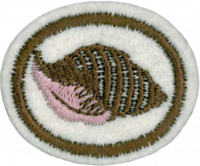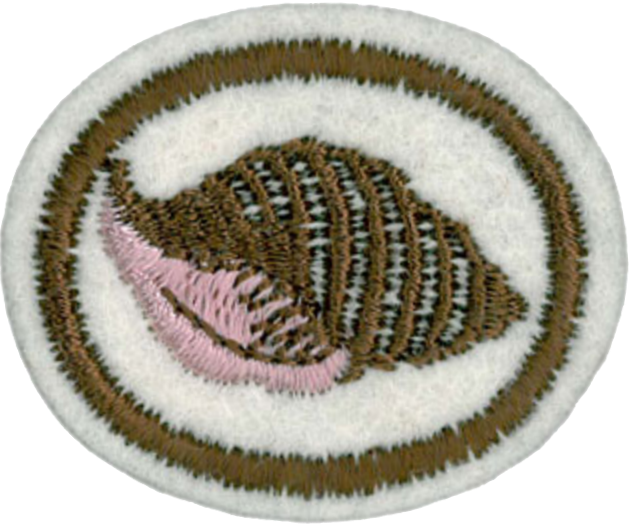Difference between revisions of "AY Honors/Shells/Answer Key/es"
From Pathfinder Wiki
(Created page with "{{clear}}") |
|||
| (18 intermediate revisions by 2 users not shown) | |||
| Line 1: | Line 1: | ||
| − | + | {{HonorSubpage}} | |
| − | |||
| − | {{ | ||
| − | |||
| − | |||
| − | |||
| − | |||
| − | |||
| − | |||
| − | |||
| − | }} | ||
| − | |||
| − | |||
<section begin="Body" /> | <section begin="Body" /> | ||
{{ansreq|page={{#titleparts:{{PAGENAME}}|2|1}}|num=1}} | {{ansreq|page={{#titleparts:{{PAGENAME}}|2|1}}|num=1}} | ||
| Line 56: | Line 44: | ||
{{ansreq|page={{#titleparts:{{PAGENAME}}|2|1}}|num=3}} | {{ansreq|page={{#titleparts:{{PAGENAME}}|2|1}}|num=3}} | ||
<noinclude></noinclude> | <noinclude></noinclude> | ||
| − | <!-- 3. ¿Se encuentran todos los moluscos en las playas? ¿En qué otro lugar se encuentran? ¿Qué áreas del mundo ofrecen la variedad más grande de conchas? --> | + | <!-- 3. ¿Se encuentran todos los moluscos en las playas? ¿En qué otro lugar se encuentran? ¿Qué áreas del mundo ofrecen la variedad más grande de conchas? --> |
{{clear}} | {{clear}} | ||
| Line 64: | Line 52: | ||
{{ansreq|page={{#titleparts:{{PAGENAME}}|2|1}}|num=4}} | {{ansreq|page={{#titleparts:{{PAGENAME}}|2|1}}|num=4}} | ||
<noinclude></noinclude> | <noinclude></noinclude> | ||
| − | <!-- 4. | + | <!-- 4. Describir el movimiento de los moluscos de un lugar a otro. --> |
| − | |||
{{clear}} | {{clear}} | ||
| Line 73: | Line 60: | ||
{{ansreq|page={{#titleparts:{{PAGENAME}}|2|1}}|num=5}} | {{ansreq|page={{#titleparts:{{PAGENAME}}|2|1}}|num=5}} | ||
<noinclude></noinclude> | <noinclude></noinclude> | ||
| − | <!-- 5. | + | <!-- 5. ¿Cómo los moluscos se protegen a sí mismos? --> |
| − | |||
<noinclude></noinclude> | <noinclude></noinclude> | ||
| Line 80: | Line 66: | ||
{{ansreq|page={{#titleparts:{{PAGENAME}}|2|1}}|num=6}} | {{ansreq|page={{#titleparts:{{PAGENAME}}|2|1}}|num=6}} | ||
<noinclude></noinclude> | <noinclude></noinclude> | ||
| − | <!-- 6. | + | <!-- 6. ¿Cómo están hechas las conchas de los moluscos y de qué materiales están hechas? --> |
| − | |||
<noinclude></noinclude> | <noinclude></noinclude> | ||
| Line 87: | Line 72: | ||
{{ansreq|page={{#titleparts:{{PAGENAME}}|2|1}}|num=7}} | {{ansreq|page={{#titleparts:{{PAGENAME}}|2|1}}|num=7}} | ||
<noinclude></noinclude> | <noinclude></noinclude> | ||
| − | <!-- 7. | + | <!-- 7. Enumerar y explicar cinco formas en que son utilizadas las conchas por el hombre. --> |
| − | |||
| − | |||
| − | |||
| − | |||
| − | |||
| − | |||
| − | |||
| − | |||
| − | |||
| − | |||
| − | |||
<noinclude></noinclude> | <noinclude></noinclude> | ||
| Line 104: | Line 78: | ||
{{ansreq|page={{#titleparts:{{PAGENAME}}|2|1}}|num=8}} | {{ansreq|page={{#titleparts:{{PAGENAME}}|2|1}}|num=8}} | ||
<noinclude></noinclude> | <noinclude></noinclude> | ||
| − | <!-- 8. | + | <!-- 8. Explicar los términos «unívalvos» y «bívalvos» tal como se aplica a los moluscos. --> |
| − | |||
| − | |||
| − | |||
| − | |||
<noinclude></noinclude> | <noinclude></noinclude> | ||
| Line 114: | Line 84: | ||
{{ansreq|page={{#titleparts:{{PAGENAME}}|2|1}}|num=9}} | {{ansreq|page={{#titleparts:{{PAGENAME}}|2|1}}|num=9}} | ||
<noinclude></noinclude> | <noinclude></noinclude> | ||
| − | <!-- 9. | + | <!-- 9. Dar el nombre común de cinco diferentes clases de conchas y nombrar de su propia colección un molusco de cada clase. --> |
| − | |||
| − | |||
| − | |||
{{clear}} | {{clear}} | ||
| Line 153: | Line 120: | ||
{{ansreq|page={{#titleparts:{{PAGENAME}}|2|1}}|num=10}} | {{ansreq|page={{#titleparts:{{PAGENAME}}|2|1}}|num=10}} | ||
<noinclude></noinclude> | <noinclude></noinclude> | ||
| − | <!-- 10. | + | <!-- 10. Hacer una colección de 20 diferentes conchas, clasificarlos y mencionar dónde fue encontrada cada una y cuándo llegó a su posesión. --> |
| − | |||
{{clear}} | {{clear}} | ||
| Line 164: | Line 130: | ||
{{ansreq|page={{#titleparts:{{PAGENAME}}|2|1}}|num=11}} | {{ansreq|page={{#titleparts:{{PAGENAME}}|2|1}}|num=11}} | ||
<noinclude></noinclude> | <noinclude></noinclude> | ||
| − | <!-- 11. | + | <!-- 11. ¿Cuál es la fuente de perlas? ¿Qué lecciones espirituales nos enseñan las perlas? Leer y discutir de Palabras de Vida del Gran Maestro de Elena G. de White, páginas 82 a 92. --> |
| − | |||
| − | |||
{{clear}} | {{clear}} | ||
| Line 187: | Line 151: | ||
{{ansreq|page={{#titleparts:{{PAGENAME}}|2|1}}|num=12}} | {{ansreq|page={{#titleparts:{{PAGENAME}}|2|1}}|num=12}} | ||
<noinclude></noinclude> | <noinclude></noinclude> | ||
| − | <!-- 12. | + | <!-- 12. Empareje los textos bíblicos que mejor respondan A-J: --> |
{{clear}} | {{clear}} | ||
| Line 200: | Line 164: | ||
{{clear}} | {{clear}} | ||
| − | + | {{clear}} | |
| − | |||
| − | + | {{clear}} | |
| − | |||
| − | + | {{clear}} | |
| − | + | {{clear}} | |
| − | |||
| − | + | {{clear}} | |
| − | |||
| − | + | {{clear}} | |
| − | |||
| − | + | {{clear}} | |
| − | |||
| Line 225: | Line 183: | ||
<noinclude></noinclude> | <noinclude></noinclude> | ||
==Referencias== | ==Referencias== | ||
| − | |||
<noinclude></noinclude> | <noinclude></noinclude> | ||
| − | + | {{CloseHonorPage}} | |
Latest revision as of 00:33, 15 July 2022
1
¿Cuál es el significado del término «molusco»?
2
Identificar a partir de conchas o dibujos los siguientes:
2a
Manto
2b
Pie
2c
Dientes
2d
Costillas
2e
Válvula
2f
Margen dorsal
2g
Ápice
2h
Opérculo
2i
Canal
3
¿Se encuentran todos los moluscos en las playas? ¿En qué otro lugar se encuentran? ¿Qué áreas del mundo ofrecen la variedad más grande de conchas?
4
Describir el movimiento de los moluscos de un lugar a otro.
5
¿Cómo los moluscos se protegen a sí mismos?
6
¿Cómo están hechas las conchas de los moluscos y de qué materiales están hechas?
7
Enumerar y explicar cinco formas en que son utilizadas las conchas por el hombre.
8
Explicar los términos «unívalvos» y «bívalvos» tal como se aplica a los moluscos.
9
Dar el nombre común de cinco diferentes clases de conchas y nombrar de su propia colección un molusco de cada clase.
10
Hacer una colección de 20 diferentes conchas, clasificarlos y mencionar dónde fue encontrada cada una y cuándo llegó a su posesión.
11
¿Cuál es la fuente de perlas? ¿Qué lecciones espirituales nos enseñan las perlas? Leer y discutir de Palabras de Vida del Gran Maestro de Elena G. de White, páginas 82 a 92.
Comentarios de Elena de White
El libro de Elena de White, Palabras de vida del gran Maeastro, se puede leer por internet. Las páginas requeridas aquí se puede encontrar en el capítulo 9.
12
Empareje los textos bíblicos que mejor respondan A-J:
| Levítico 11:9 y 10 | a. ¿En qué día fueron creadas las criaturas acuáticas? |
| Hechos 16:14 | b. El número de criaturas acuáticas es innumerable. |
| Isaías 50:2 | c. Criaturas acuáticas perecen fuera del agua. |
| Apocalipsis 21:21 | d. Job consideró el coral de gran valor. |
| 1 Timoteo 2:9 | e. Salomón estaba familiarizado con la vida marina. |
| Génesis 1:20 y 21 | f. Jesús utiliza 2 veces una concha para enseñar una lección espiritual. |
| 1 Reyes 4:33 | g. Una empresaria se dedicaba a la venta de los famosos tintes de púrpura garantizados, tomado de los mariscos del Mediterráneo llamado Murex. |
| Salmo 104:25 | h. Pablo no apoya el uso de perlas. |
| Mateo 7:6; 13:45 y 46 | i. Los moluscos son impropios para la alimentación. |
| Job 28:18 | j. Las 12 puertas de la Santa Ciudad son 12 perlas. |


